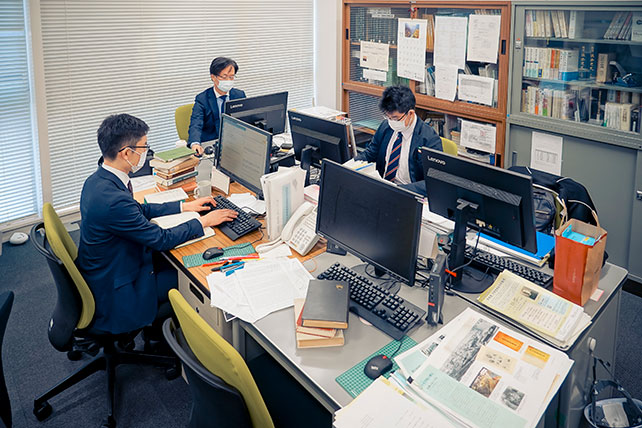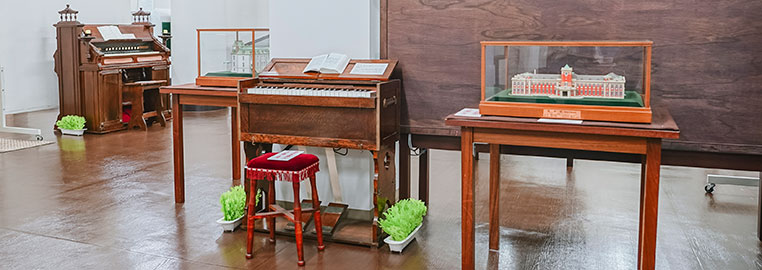Aoyama Gakuin Institute of History
~Its role and outlook~
The Aoyama Gakuin University Research Institute for History will open in April 2021 as an affiliated research institute of Aoyama Gakuin University.
Aoyama Gakuin will celebrate its 150th anniversary in November 2024. As part of its commemorative projects, Aoyama Gakuin began compiling the "150-Year History of Aoyama Gakuin" in 2014 and established the "Aoyama Gakuin 150-Year History Compilation Office" within its Resource Center. On April 1, 2021, this history compilation office was expanded to open the "Aoyama Gakuin History Research Institute," an affiliated research institute of Aoyama Gakuin University.
 The Role of the Aoyama Gakuin Institute of History
The Role of the Aoyama Gakuin Institute of History
Director of the Aoyama Gakuin Institute of History, Professor of the Department of History, Faculty of Letters
Kazuyuki Kobayashi
Completed his doctoral studies at the Graduate School of Humanities and Social Sciences, Aoyama Gakuin University. PhD (History) (Aoyama Gakuin University). After working as an assistant at the Faculty of Humanities of the same university, a chief researcher at the Department of Archives and Mausolea of the Imperial Household Agency, and an associate professor at the Faculty of Humanities of Komazawa University, he was appointed professor at the Faculty of Humanities of Aoyama Gakuin University in 2006, where he remains to this day. In April 2021, he was appointed director of the Aoyama Gakuin University Institute of History. His major works include Meiji Constitutional Politics and the House of Peers (Yoshikawa Kobunkan, 2002), Tanijo Castle: Patriots of the Meiji Era (Chuko Shinsho, 2011), and The Era of Nationalism: People Who Supported Meiji Japan (Kadokawa Sensho, 2017).

The Aoyama Gakuin University History Research Institute, which opened in April 2021, aims to study the various materials collected by the university to shed light on the history of the university since its founding, while also contributing to the university's history education. At the same time, it aims to contribute to the influence of Christian culture in modern Japan and the development of research on modern and contemporary Japanese history. To achieve these goals, the institute will play the following five roles:
(1) Compilation of the history of Aoyama Gakuin
We will conduct empirical research into the historical role of Aoyama Gakuin in modern Japanese history, and publish the results of that research in the form of books, reports, or research journals related to the history of Aoyama Gakuin. Until the 150th anniversary of the founding of Aoyama Gakuin in 2024, our priority task will be compiling the 150-Year History of Aoyama Gakuin. Even after the compilation of the history is completed, we will continue the work necessary for compiling future histories of the academy, and will publish the results of our research.
(2) Research on the history of Christian education, with a focus on Aoyama Gakuin
Positioning the Institute as a joint research institute across the university, transcending the boundaries of the various faculties and schools within the university, it will set up research projects as necessary and work in close collaboration with researchers from the various schools and outside the university to promote historical research on Christian education and Christian culture.
(3) Collection and research of materials related to Aoyama Gakuin
In cooperation with the Aoyama Gakuin Materials Center, we will collect materials related to Aoyama Gakuin, its alumni and related parties, and conduct research. In addition, we will organize materials collected for the compilation of the academy's history and promote their use in research and education.
(4) Education based on historical research findings on Aoyama Gakuin
The findings of the research conducted on the history of Aoyama Gakuin will be used to support classes and provide lectures at the affiliated schools, and will also be given back to society through activities such as lectures.
(5) Other
The Center will cooperate with the preparations for the opening of a museum (a facility that meets the standards for a museum-equivalent facility) to be established by Aoyama Gakuin. In addition, the Center will fulfill its role as a research and educational organization attached to the university in order to provide a full range of school history education.
 Published the data section of "Aoyama Gakuin 150 Year History" (Volumes I and II)
Published the data section of "Aoyama Gakuin 150 Year History" (Volumes I and II)
Currently, the main task of our institute is to compile the "150-Year History of Aoyama Gakuin," in accordance with (1). The "150-Year History of Aoyama Gakuin" is composed of three parts: a data section (Volumes I and II) that mainly contains written materials, a general history section (Volumes I and II), and a separate volume "150 Years of Aoyama Gakuin in Photographs," which mainly contains visual materials.
Volume 1 of the materials section begins with materials from the prewar period, such as the "Girls' Elementary School," one of the origins of the academy, while Volume 2 is the postwar period, and contains materials up to January 2021. In compiling the book, priority was given to official materials such as the records of board meetings, but it also includes familiar materials such as memoirs of people who lived through that time and university publications, aiming to create a "collection of materials that is easy to read and understand." Another distinctive feature of "The 150-Year History of Aoyama Gakuin" is that it includes as much material as possible related to each of the schools established at the academy, reflecting the equal relationship between the schools established at the academy, which is a characteristic of our university.
All of the volumes, the reference material, the general history, and "150 Years of Aoyama Gakuin in Photographs," are based on empirical research based on objective historical materials, and we aim to produce history books that are worthy of academic recognition. Volume 1 of the reference material was published in March 2019, and Volume 2 of the reference material was published in March 2021. We are currently compiling Volume 1 of the general history and the separate volume "150 Years of Aoyama Gakuin in Photographs."
General histories compiled by Aoyama Gakuin have already been published, including the "90-Year History of Aoyama Gakuin," the "50-Year History of Aoyama Gakuin University," and the "65-Year History of Aoyama Gakuin Women's Junior College." However, as a general history covering Aoyama Gakuin as a whole, the new "150-Year History of Aoyama Gakuin" is positioned as a new "general history" that takes into account recent historical research.
The background to the publication of this comprehensive history is that the historical evaluation of the academy has been established to a certain extent since its early days as a postwar new school, and the project to compile the academy history has gained deep understanding from within the academy, including the chairman, president, and principal. As a result, the necessary environment was created to proceed with the project to compile a comprehensive academy history, leading to the establishment of this institute.
The basis for compiling the "150 Year History of Aoyama Gakuin" is the collection and verification of various materials. However, since most of the materials from that time were burned in the Great Kanto Earthquake and air raids during the war, there are not many materials left on campus. Therefore, in order to collect materials, it was necessary to visit various public institutions such as the Tokyo Metropolitan Archives and also to use personal materials of related individuals. In addition, during the current COVID-19 pandemic, many difficulties arose, such as restrictions on entry to the academy and the closure of various institutions, but as a result of the institute's united efforts in compiling the book, we were able to publish the materials edition on the originally scheduled date.
Currently, in addition to myself, the director, there are several other staff members working on this project. The compilation work, including writing the manuscript, requires a high level of expertise, so the efforts of two assistants and the editorial assistants in particular were of great significance. The compilation of "The 150th Anniversary History of Aoyama Gakuin" would not have been possible without them, and I am always grateful for their daily work.
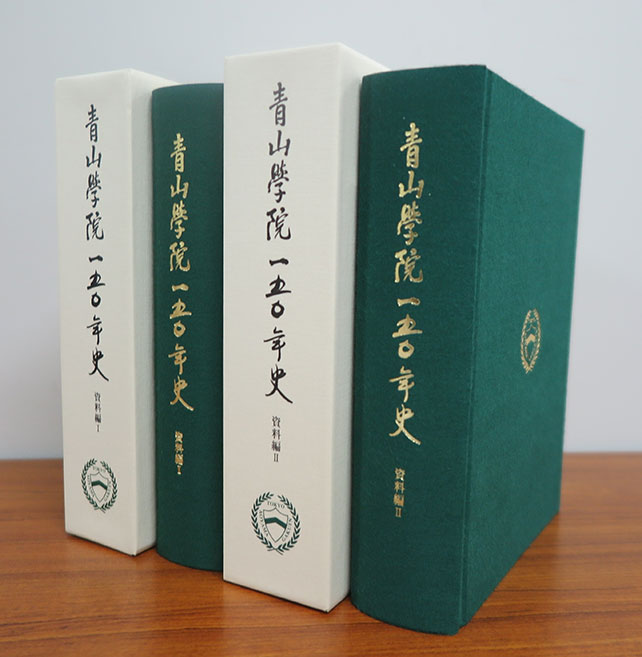
"Aoyama Gakuin 150 Year History" Reference Book (Volumes I and II)

The bookmark is inspired by the color of the sash "fresh green" worn by the university's track and field club (long distance block).
Thanks to all of you, we've reached the halfway point.
Aoyama Gakuin History Research Institute Assistant Rei Hinata
My specialty is modern Japanese history. In recent years, I have been reading and researching historical documents from the period when Japanese military doctors advanced into Korea and China. I am endlessly interested in how diplomats and soldiers perceived the situation of Christian missionary work in Korea and China, and what issues they faced. In the second volume of documents published in March 2021, I was in charge of "Part 1: Reconstruction and Development of Aoyama Gakuin," which covers the general history from the end of the war to the present day. In the first volume of general history scheduled for publication in 2022, I am mainly in charge of Aoyama Gakuin during the Taisho and Showa periods. Since this was the first full-scale official history since "The 90th Year History of Aoyama Gakuin," I was relieved when the publication of the two volumes of documents was completed. This is all thanks to the help of everyone involved with the school. In particular, I feel the great presence of Professor Kazuyuki Kobayashi, who is trying to make the compilation a success. In the future, we will be working on two general history books and "150 Years of Aoyama Gakuin in Photographs," so we will be keeping ourselves on edge.

I was in charge of compiling a very significant book.
Daigo Sato, Research Associate, Aoyama Gakuin University History Research Institute
Like Hinata-sensei, I also specialize in modern Japanese history, and I collect and analyze historical materials from the compilation of local history journals in the Meiji period that remain in public archives and libraries around the country. In the historical materials left by past compilers, I can find many thoughts and concerns that are similar to the ones I feel on a daily basis when compiling the history of the academy. In compiling the "150-Year History of Aoyama Gakuin," in the material volume II, I was in charge of "Part 2: Development of the Established Schools," which deals with the progress of each established school after the war. In the general history volume I, I am mainly in charge of Aoyama Gakuin and Aoyama Girls' Academy in the Meiji period. Since I took up my post in 2020, the COVID-19 pandemic has hit me, and I was a little worried about compiling the book without knowing anything about a campus without students. However, thanks to the accumulated experience of compiling the school history and the help of everyone involved in the compilation, including Professor Kobayashi, I was somehow able to complete the compilation of Volume II of the Materials. Volume II of the Materials, which is 893 pages long, has become a very meaningful book to me.
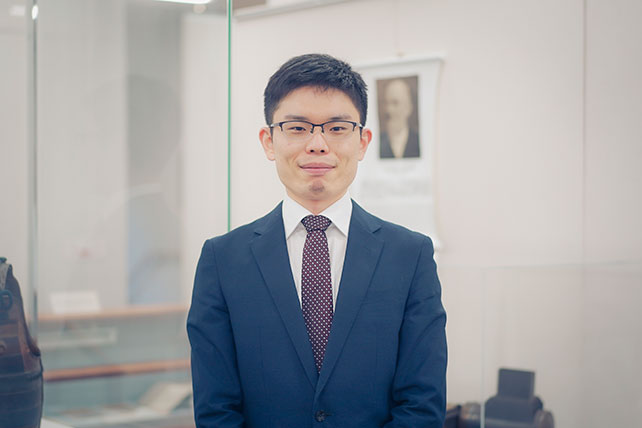
 The significance and prospects of studying the history of the academy
The significance and prospects of studying the history of the academy
First of all, what is the significance of studying the history of Aoyama Gakuin? For example, by clarifying the history from the founding, we can reaffirm the founding spirit and use it as a foundation for future innovation. In addition, fostering a school identity can be said to be one of the major significances of school history education.
In addition to these, something else became clear as we proceeded with compiling "Aoyama Gakuin 150 Year History." That is, the path walked by Aoyama Gakuin and the people involved in its founding occupy an important position in the larger flow of modern Japanese history, and therefore studying the history of our university leads to elucidation of modern Japanese history, which developed while also accepting Christian culture from Europe and the United States. We came to believe that knowledge gained from studying the history of Aoyama Gakuin should not be limited to those associated with our university as the history of our own university, but should be shared widely among history researchers, including those from other universities. In compiling "Aoyama Gakuin 150 Year History," we are working with the ambition of making a broad contribution to Japanese historical research.
Going forward, we plan to publish Volumes I and II of the general history series, and then publish "150 Years of Aoyama Gakuin in Photographs" by November 2024, the 150th anniversary of the founding of the academy.
Even after the publication of "Aoyama Gakuin 150 Year History," the research into the history of the academy will continue. As stated in (4) of the role of the institute, the results should be returned to the university's educational support and society at large, and an initiative that has already begun is cooperation with the university's educational curriculum, "Aoyama Standard Courses." Furthermore, in the future, it is also considered to set up classes such as "Aoyama Gakuin in Modern Japanese History" and "Christian Education and Aoyama Gakuin," as well as to support various classes, including at affiliated schools, on themes such as social work and study abroad programs that the university has traditionally been involved in.
We will continue to cooperate with our university's Resource Center in collecting materials and conducting research, and when the Resource Center holds events, our institute staff will provide expert explanations to participants, and we plan to collaborate in various other areas.
As part of the Institute's role (2), we are also planning a research project centered around the Institute, in which the relevant parties of the institute's affiliated schools and specialist researchers from other universities will also participate. The results of this research will contribute to education and research support both within and outside the university, and we are considering making them available to the general public through lectures, symposiums, etc.
The Institute's future direction is to contribute to the development of various specialized fields, including modern Japanese history, by conducting deeper research into the historical position of our university in modern Japan, and by clarifying the historical significance of Christian education in Japan. In keeping with the founding spirit of our university, we will continue to work to properly convey the results of these research to our students, researchers, and the general public, so that they can gain a deeper understanding.

Symposium held as part of collaboration with researchers
Kazuyuki Kobayashi, Director of the Aoyama Gakuin Institute of History, reflects on the opening symposium
At the symposium "Possibilities for Research on School History and University History" held on Saturday, November 27, 2021, speakers reported on 1) brief histories of each university, 2) the current status and challenges of the history compilation project, and 3) the role and potential of the history compilation project. The presentation included some very interesting and stimulating topics, such as the relationship between the archives of the University of Tsukuba's predecessor schools and the project to compile the university's history, the significance of the foundational work of compiling the University of Tokyo's history and his aspirations as a historian, the compilation of a collection of materials at Keio University and its use in research, and the use of the Wiki system in writing a general history at Waseda University. In the comments, the speakers asked about the use of the "materials" section of the history, the use of the results of the history in "political history," and the meaning of asking what a university is through the history. Through the replies and questions and answers from the audience, the significance of compiling the history and researching school history became clear from many angles. This time, the fact that the event was held in person with thorough infection prevention measures in place made it possible to interact with the speakers and nearly 100 visitors extremely meaningful. In the future, the Institute for College History will continue to deepen research into the history of the college through symposiums and study groups such as these.
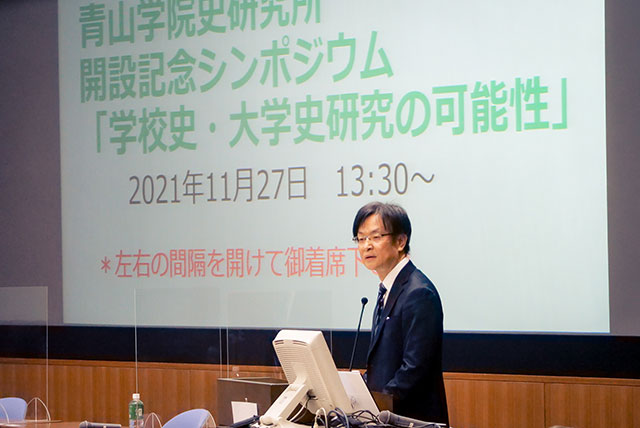
Director Kobayashi, who served as the symposium's moderator and coordinator
